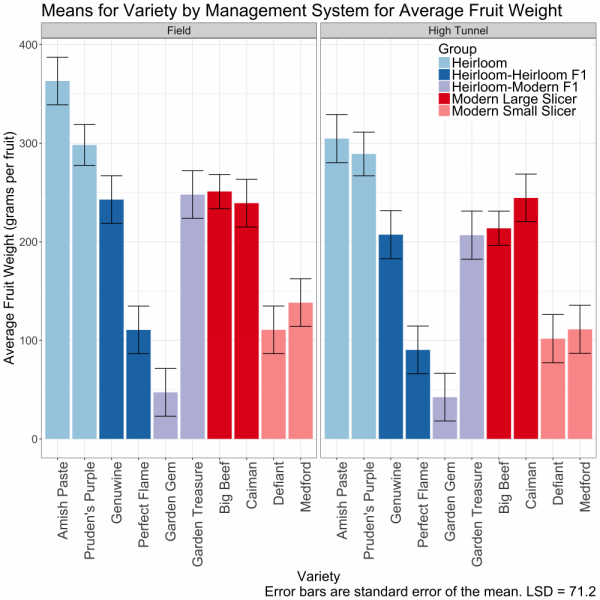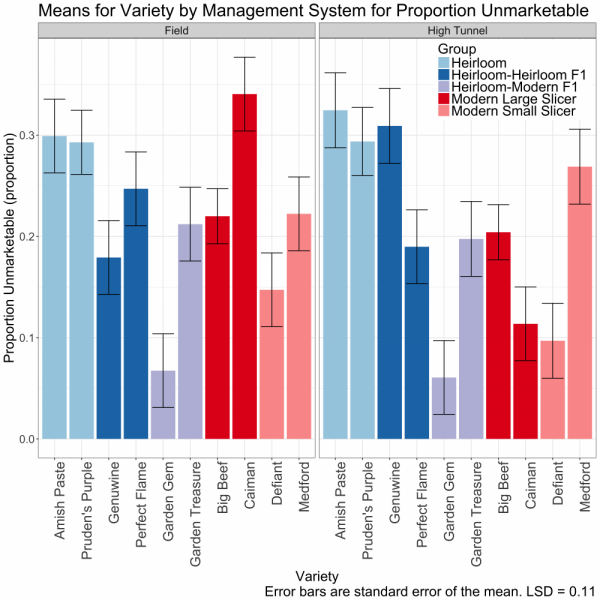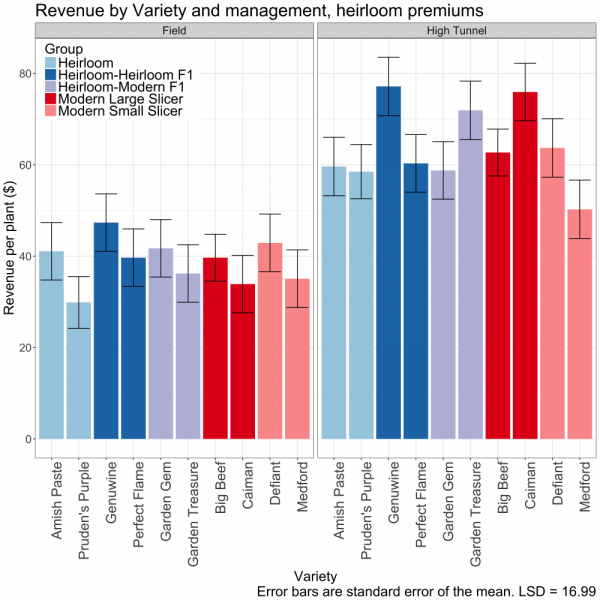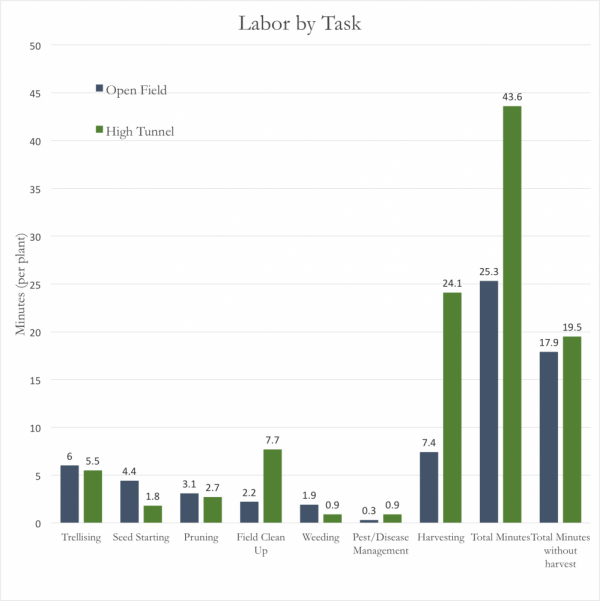eOrganic authors:
Terry Hodge, University of Wisconsin-Madison
Kitt Healy, University of Wisconsin-Madison
Brian Emerson, University of Wisconsin-Madison
Julie Dawson, University of Wisconsin-Madison
Introduction
Tomatoes are an important crop for small to mid-sized farmers selling directly to customers through farmers markets, Community Supported Agriculture (CSA), and restaurant sales. In this multi-year study (2014-2016), we evaluated 15 different tomato varieties for performance in high tunnel and open field management (marketable/unmarketable yield, average fruit weight, fruit number, and disease). Varieties were selected based on the potential for production in organic systems and were comprised of three different genetic backgrounds (heirloom, modern and 50% heirloom/50% modern crosses). We found management system (high tunnel vs. open field) to be the most important factor in determining both marketable yield and disease incidence. Although the high tunnel system improved variety performance overall, we observed differences in relative performance of some varieties between the two systems. We also found that causes of unmarketable fruit differed greatly between the high tunnel and open field, suggesting that breeding varieties to overcome specific issues in each system might boost marketable yield beyond the season extension benefit.
Key Findings
- The high tunnel produced 18.7lbs/plant marketable fruit compared to 10.8lbs/plant in the field.
- High yielding varieties in the field tend to be high yielding in the high tunnel.
- Foliar disease coverage was about 78% of leaf area at mid-season in the open field compared to 17% in the high tunnel.
- Each management system had different primary causes of unmarketable fruit.
- Marketable yield was the most important factor for revenue potential.
- Price premiums (e.g. for heirlooms) did not make up for differences in marketable yield.
Background
Tomatoes are very important for direct market vegetable growers, often serving as a key crop for farm income. However, growers in the North Central Region may face short growing seasons and high disease pressure. Additionally, many varieties may not be adapted for organic or low-input systems. As a result, growers are increasing their use of high tunnels for tomato production (Carey et al., 2009). Previous studies have demonstrated the benefits of high tunnel production, which include higher marketable yields, lower disease pressure, and increased fruit quality (O’Connell 2007, Rogers and Wszelaki 2012, Powell et al., 2014; Taber et al., 2015). However, many of these studies only evaluated a few tomato varieties at a time, often from the same market class. To add to the growing body of knowledge, researchers at the University of Wisconsin-Madison conducted organic tomato variety trials from 2014 to 2016 at the West Madison Agricultural Research Station (WMARS) near Madison, WI. The purpose of these trials was to screen varieties from different genetic backgrounds for production and quality in the North Central region, compare high tunnel and open field management, and compare revenue potential for different management systems and varieties.
Methods
Over the course of three years, ten tomato varieties were grown at the West Madison Agricultural Research Station (WMARS) (Table 1) in both a high tunnel and an open field system, under organic management. The varieties were provided by independent breeders and seed companies, and were assumed to have important traits of interest (good fruit quality, disease tolerance, etc.) for North Central region farmers. They were selected for inclusion based on screening trials, so that the study described here is based on ten varieties we know are adapted to the North Central Region. Yearly data from additional varieties not included in this trial across all three years is available in trial reports at https://seedtokitchen.horticulture.wisc.edu/trial-results.html.
The varieties chosen represented different genetic backgrounds. There were two true heirlooms, two heirloom-by-heirloom F1 hybrids, two heirloom-by-modern F1 hybrids, two modern small slicers and two modern large slicers. The genetic backgrounds are given in Table 1 and varieties are shaded by their genetic background in the figures.
Table 1: Tomato varieties used in the trials
| Variety Name | Breeder | Growth Habit | Mating Type | Group |
|---|---|---|---|---|
| A6 (Amish heirloom) | Craig Grau | Indeterminate | Open Pollinated | Heirloom |
| Pruden’s Purple | Heirloom | Indeterminate | Open Pollinated | Heirloom |
| Genuwine (Heirloom Marriage) | Ball-PanAmerican | Semi-Determinate | F1 Hybrid of two heirlooms | Heirloom-Heirloom F1 |
| Perfect Flame (Heirloom Marriage) | Ball-PanAmerican | Semi-Determinate | F1 Hybrid of two heirlooms | Heirloom-Heirloom F1 |
| Garden Gem | Harry Klee, University of Florida | Determinate | F1 Hybrid | Heirloom-Modern F1 |
| Garden Treasure | Harry Klee, University of Florida | Indeterminate | F1 Hybrid | Heirloom-Modern F1 |
| Big Beef | Seminis | Indeterminate | F1 Hybrid | Large Slicer |
| Caiman | Vitalis | Indeterminate | F1 Hybrid | Large Slicer |
| Defiant | Johnny’s Selected Seeds | Semi-Determinate | F1 Hybrid | Small Slicer |
| Medford | Oregon State University | Determinate | Open Pollinated | Small Slicer |
Trials were grown on certified organic land at the West Madison Agricultural Research Station (WMARS). A high tunnel production area of 30 feet x 80 feet and an open field production area of 30 feet x 80 feet was used. Each variety was planted with two replications in a randomized complete block design in each management system. Tomatoes in the high tunnel were pruned to two main leaders and trellised using tomato clips and twine attached to cross beams. The open field tomatoes were trellised using T-posts and a basket weave method. Each system was planted with a cover crop and amended with compost and organic fertilizer (pelletized chicken manure or feather meal) each year to reach the recommended 150 pounds of nitrogen per acre. Plastic mulch and drip irrigation were used in both systems. Obligatory preventative measures at the research station were applied for late blight. This entailed applications of EF400, an organic approved fungicide in both systems every 10-14 days after late blight was reported in Dane County, where the research station is located. Note:Before using any pest control product in your organic farming system, read the label to be sure that the product is labeled for the crop and pest you intend to control, and make sure it is legal to use in the state, county, or other location where it will be applied, read and understand the safety precautions and application restrictions, and make sure that the brand name product is listed in your Organic System Plan and approved by your USDA-approved certifier. If you are trying to deal with an unanticipated pest problem, get approval from your certifier before using a product that is not listed in your plan—doing otherwise may put your certification at risk. Note that OMRI and WSDA lists are good places to identify potentially useful products, but all products that you use must be approved by your certifier. For more information on how to determine whether a pest control product can be used on your farm, see the article, Can I Use This Input On My Organic Farm?
Measurements taken included marketable yield, marketable fruit count, average individual fruit weight, unmarketable yield, and disease incidence. Tomatoes were harvested once a week from mid-July (week 29) to as late as November 20th (week 46) in the high tunnel. Fruit were considered unmarketable if they suffered from low quality due to issues such as rot, cracking, splitting, damage by rodents or insects and disease. Marketable fruit were counted and weighed and unmarketable fruit was weighed. Average fruit weight (marketable yield / marketable number) and the proportion unmarketable fruit (unmarketable yield/total yield) were calculated from measured data. Percentage disease incidence was recorded at peak production each year as the amount of disease present with 0 percent representing no disease and 100 percent representing all foliage damaged by disease. Prevalent diseases were septoria leaf spot (Septoria lycopersici ) and early blight (Alternaria linariae).
These data were analyzed using an analysis of variance (ANOVA) to determine which factors (management, variety, and year) were important and to calculate means for these traits. We analyzed all two- and three-way interactions but were most interested in interactions involving management and variety, especially crossover interactions. Any crossover interactions between management systems would indicate that different varieties should be recommended for the two management systems.
In addition, an informal price survey was conducted via text message with six farmers weekly during the summer of 2017 to determine different tomato pricing strategies used by direct-market farmers. After analyzing the survey responses, three pricing strategies emerged. They were (1) a price premium at the beginning and end of the season, (2) a price premium for heirlooms and (3) a price premium at the beginning and end of the season, with an additional price premium for heirlooms.
These strategies were generalized to calculate revenue for the trial varieties (Table 2). The weekly marketable yield from the WMARS trials was multiplied by the price for each strategy to calculate the revenue potential for each variety and management strategy. For the purposes of revenue calculations, heirlooms and heirloom-by-heirloom F1s were considered heirlooms, and everything else was considered a modern slicer. Labor time for major tasks over the season was also recorded for each management system in 2017. The fixed costs of the high tunnel were not included in the revenue calculations. A high tunnel with W trusses (to support tomato trellising weight) costs approximately $7,000 (www.zimmermanshightunnels.com). Adding automated sides and additional bracing to allow a mobile structure brings this to approximately $10,000 (Zimmerman's, personal communication). Labor costs to build and install the high tunnel can as much as double this figure, if not provided by the farmers themselves. Estimates of fixed costs per year are approximately 0.49 (Sydorovych et al., 2013), which would be $1,323 on a 30x90 foot high tunnel.
Table 2. Generalized pricing strategies used in calculating revenue and earning potential per plant based on pricing strategy and management system, averaged over varieties in the trial
| Strategy | Group | Week | Price / pound | Field revenue/plant | High Tunnel revenue / plant |
|---|---|---|---|---|---|
| 1 | All Varieties | 29-31 (~Jul. 18-Aug. 1) | $4.50 | $33a | $63b |
| 32-41 (~Aug. 8-Oct. 16) | $3.00 | ||||
| 42-46 (~Oct. 17- Nov. 20) | $4.50 | ||||
| 2 | Heirloom, Heirloom-Heirloom F1 | 29-46 (~Jul. 18-Nov.20) | $4.00 | $38a | $65b |
| Heirloom-Modern F1, Large Slicer, Small Slicer | 29-46 (~Jul. 18-Nov.20) | $3.00 | |||
| 3 | Heirloom, Heirloom-Heirloom F1 | 30-31 (~Jul. 25-Aug. 7) | $6.50 | $38a | $68b |
| 32-41 (~Aug. 8-Oct. 16) | $4.00 | ||||
| 42-45 (~Oct. 17- Nov. 20) | $6.50 | ||||
| Heirloom-Modern F1, Large Slicer, Small Slicer | 30-31 (~Jul. 25-Aug. 7) | $4.50 | |||
| 32-41 (~Aug. 8-Oct. 16) | $3.00 | ||||
| 42-46 (~Oct. 17- Nov. 20) | $4.50 |
Results
Marketable Yield
Marketable yield per plant is shown in Figure 1A. Management system (high tunnel vs. open field) was the most important factor in determining marketable yield. All varieties saw increases in marketable yield in the high tunnel, but a few varieties saw a more pronounced benefit, leading to a management by variety interaction. For example, the variety ‘Caiman’, which was bred for high tunnel production, was the most productive variety in the high tunnel but not nearly as good in the field suggesting that its performance may indeed be optimized for high tunnel production. ‘Garden Treasure’, a variety bred in Florida, also saw a more substantial increase than other varieties in the high tunnel. These two varieties were the highest yeilding in the high tunnel, followed closely by several others (see Figure 1A). ‘Defiant’ and ‘Garden Gem’ were the highest yielding varieties in the field, although varietal performance in the field was not as differentiated as in the high tunnel, and most varieties peforemed moderatly well in the field, without significant differences between them. There was a significant interaction between variety and year as well, in general, varieties showed more stable performance in the high tunnel in terms of their relative performance, and were more variable in terms of field performance.
Average Fruit Weight
Average fruit weight is shown in Figure 1B. The most important factor for average fruit weight was variety. The heirloom varieties had the highest fruit weight in both systems. In our discussions with growers, one drawback to heirloom varieties is that they often have much larger fruit than desirable. The variety with the lowest fruit weight in both systems was ‘Garden Gem’. On average, fruit in the field tended to be slightly larger than fruit in the high tunnel, perhaps due to an excess of water at certain times. We did not see significant interactions between variety and management system or variety and year for fruit weight. In the high tunnel, the average fruit weight ranged from 1.5 to 13.7 ounces, with an average of 6.5 ounces. In the open field, the average fruit weight range was from 1.7 to 13.2 ounces, with a mean of 7.1 ounces.
Proportion Unmarketable Yield
The unmarketable yield by variety is show in Figure 1C. The most important factor for the proportion of unmarketable fruit was year, which speaks to the year-to-year variation in weather, disease cycles, etc. The variety with the lowest proportion of unmarketable fruit for both the high tunnel and open field system was ‘Garden Gem’, with a proportion of unmarketable of 0.061 and 0.067 (6.1% and 6.7%) respectively. In general, the high tunnel proportion of unmarketable fruit ranged from 0.061 to 0.33 with a mean of 0.19. The proportion of unmarketable fruit in the open field ranged from 0.067 to 0.34, with a mean of 0.23.
We saw a significant genotype by management interaction between systems, likely due to differing factors that contributed to unmarketable fruit between the two management systems. In the high tunnel, blossom end rot, rodent damage, and fruit and hornworm damage were common. In the open field, however, production suffered mostly from splitting, cracking, and various foliar diseases. Varieties that suffered from problems in one system or the other were the most likely to show differences in performance between the two systems. ‘Caiman’ showed a much higher proportion of unmarketable fruit in the field, where it was susceptible to cracking, and ‘Genuwine’ showed a much higher proportion of unmarketable fruit in the high tunnel because it was extremely susceptible to blossom end rot. We also saw a significant variety by year interaction primarily due to certain years being more conducive to the causes of unmarketability. Blossom end rot was fairly severe in the high tunnel in 2015 (with ‘Genuwine’ suffering dramatically from blossom end rot in that year), and 2016 was extremely wet during peak harvest season, leading to varieties that were susceptible to cracking like ‘Caiman” having a higher proportion of unmarketable fruit than expected.
Disease Incidence
The percentage of diseased leaf area at peak production is shown in Figure 1D. The most important factor for disease incidence was management, with little variation among varieties within management system. Variety itself was not a signifiant source of variation for disease incidence. There was an interaction between variety and management, as ‘Garden Gem’ showed a higher disease incidence in the field than the high tunnel relative to other varieties. We did not see a variety by year interaction. In the high tunnel, the disease incidence ranged from 10.9 to 24.1% with a mean of 16.5%, and in the open field, the disease incidence ranged from 70.1 to 88.6%, with a mean of 78.1%.
Price Survey
Revenue potential by system and strategy is summarized in Table 3, and revenue potential per variety for a strategy of heirloom price premiums is shown in Figure 1D. Overall, marketable yield was the most important contributing factor for revenue regardless of pricing strategy. Premiums at the beginning and end of the season resulted in revenue very closely tracking marketable yield. The two heirlooms produced revenue equivalent to the lower yielding slicers for an heirloom price premium strategy, and ‘Genuwine’ had revenue equivalent to the higher yielding slicers. ‘Genuwine’ is an heirloom-heirloom F1 variety that has the appearance of an heirloom.
The high tunnel system provided more earning potential compared to the field setting for each price strategy. Table 3 gives the average revenue per plant for each strategy in each management system using the yield data from the WMARS trials. Potential revenue is also reported for an average sized high tunnel planted with the same spacing as our trials (~300 plants per 30’ x 90’ tunnel). With no price premiums, revenue in the field averaged $33/plant, and $63/plant in the high tunnel. Although pricing strategy did change the potential revenue of each market class, the most important factor was marketable yield, even when premiums were substantial. This assumes that each variety sells with the same likelihood. As a result, modern slicers were often the top earners despite price premiums for heirlooms. If modern slicers do not sell as well even with lower prices, then revenue for heirlooms may be higher. Premiums were chosen to represent the high end of what farmers were receiving, in order to illustrate the maximum possible differences among the market classes.
Labor Considerations
In our trials, the labor hour breakdown shows that the open field system required fewer overall hours compared to the high tunnel system, with 25 minutes per plant on average in the open field and 45 minutes per plant in the high tunnel. In both management systems, harvesting made up the largest percentage of labor hours, with 29% in the open field and 55% in the high tunnel. Harvesting in the high tunnel most likely took a larger portion of overall labor hours due to higher yields and season extension benefits. We calculated the labor hours both with and without harvest times for comparison. Harvesting took 16.7 minutes more per plant in the high tunnel, and the total labor was 18.3 minutes more per plant in the high tunnel. This means that added harvesting labor accounted for 91.2% of the added labor in the high tunnel. Surprisingly, the disease/pest management labor requirement in the two systems is very similar. This is most likely a result of the preventative measures applied in both systems at the research station. This category might look different in a farmer’s field or high tunnel that most likely would not be sprayed if disease was not present. Field tomatoes were also trellised using a basket weave system, so if farmers did not trellis field tomatoes or used a less intensive method this would reduce labor costs for the field.
Recommendations for Farmers
- To increase marketable yield, high tunnels can be used for season extension and for reducing the incidence of foliar disease.
- To increase revenue, it may be more worthwhile to grow a higher yielding variety rather than charging a premium for heirlooms that may have lower production.
- Several varieties discussed above performed well for many of the traits of interest.
- ‘Defiant’, a small red slicer developed by Johnny’s Selected Seeds was often among the top performers for marketable yield, disease scores and had good flavor when tasted by the field crew. Additionally, ‘Defiant’ was just below the optimal fruit weight range of 4-8 ounces (~3.9 ounces).
- ‘Caiman’ was the top producer in the high tunnel system and consistently had low numbers of unmarketable fruit in this system. ‘Caiman’ is a variety that performs well for greenhouse production and also does quite well in a high tunnel. It is a large red modern hybrid. The flavor was not quite as good as the other varieties discussed here in crew taste tests. It would be a potential alternative to 'Big Beef'.
- ‘Garden Gem’ and ‘Garden Treasure’ are heirloom-by-modern F1 varieties that are productive and have very good flavor based on crew taste tests. Seed is available from Dr. Harry Klee from the University of Florida, with commercial seed likely to be available in the near future. One potential drawback to ‘Garden Gem’ is its relatively small size that requires more harvest time. ‘Garden Treasure’ is a more standard large slicer size but does not have quite as good flavor as ‘Garden Gem’.
- For farmers seeking an heirloom appearance, ‘Genuwine’ from Ball-PanAmerican is an heirloom-by-heirloom F1 hybrid with high yields and good flavor based on crew taste tests. It did, however, suffer fairly severely from blossom end rot.
- Other more affordable methods of season extension could potentially offer similar benefits as high tunnels at a lower cost. Current research is comparing caterpillar tunnels and high tunnels for heirloom and slicer variety production.
Figures




Figure 1. Variety means by management system for each trait. A. Marketable Weight. B. Average Fruit Weight. C. Proportion Unmarketable. D. Disease Incidence.

Figure 2. Revenue potential per plant for each management system by genetic group for pricing strategy two, with premiums for heirlooms and heirloom-heirloom F1 varieties.

Figure 3. Labor in minutes per plant for each management system.
Acknowledgments
We would like to thank all the individuals and companies that provided seeds for the project; Janet Hedtcke and the staff at the West Madison Agricultural Research Station; students Thi Le, Terri Theisen, Natalie Cotter, Thomas Hickey, Keo Corak, Mariana Debernardini, Ilhulpachakatl Neubauer, Bradley Melinger, Laura Jacobson, Marissa Nix, Lucas Holiday, Sarah Lee, Molly Kreykes, Jamie Lovely and Maya Reese; Tricia Bross at Luna Circle Farm; and the farmers that participated in the pricing survey. This project was funded by the North Central Sustainable Agriculture Research and Education Program of the United States Department of Agriculture (USDA)(LNC14-357), and the Hatch Program of the USDA (WIS01775). T.L. Hodge was funded by a University of Wisconsin-Madison Science and Medicine Graduate Research Scholars Fellowship (Fall 2016-Spring 2017). Any opinions, findings, conclusions, or recommendations expressed in this publication are those of the author(s) and do not necessarily reflect the view of the U.S. Department of Agriculture.
References and Citations
- Carey, E.E., Jett, L., Lamont, W.J., Nennich, T.T., Orzolek, M.D., and Williams, K.A. 2009. Horticultural crop production in high tunnels in the United States: a snapshot. HortTechnology 19, 37–43. (Available online at:https://doi.org/10.21273/HORTSCI.19.1.37) (verified 10 Dec 2019).
- O’Connell, S. 2007. Organic heirloom tomato production in high tunnel and open field systems [Online]. Research innovations. Sustainable Agriculture Research and Education. Available at: https://www.sare.org/Learning-Center/Topic-Rooms/High-Tunnels-and-Other-Season-Extension-Techniques/Season-Extension-Cultivar-Selection-and-Variety-Trials/Organic-Heirloom-Tomato-Production-in-High-Tunnel-and-Open-Field-Systems (verified 31 December 2018).
- Powell, M., Gundersen, B., Cowan, J., Miles, C.A., and Inglis, D.A. 2014. The effect of open-ended high tunnels in western Washington on late blight and physiological leaf roll among five tomato cultivars. PLANT DIS. 98, 1639–1647. (Available online at:https://apsjournals.apsnet.org/doi/pdf/10.1094/PDIS-12-13-1261-RE) (verified 31 December 2018)
- Rogers, M.A., and Wszelaki, A.L. 2012. Influence of high tunnel production and planting date on yield, growth, and early blight development on organically grown heirloom and hybrid tomato. HortTechnology 22, 452–462. (Available online at: https://doi.org/10.21273/HORTTECH.22.4.452)(verified 26 Nov 2019).
- Sydorovych, O., Rivard, C.L., O’Connell, S., Harlow, C.D., Peet, M.M., and Louws, F.J. 2013. Growing Organic Heirloom tomatoes in the field and high tunnels in North Carolina: Comparative Economic Analysis. HortTechnology 23, 227–236. (Available online at:https://doi.org/10.21273/HORTTECH.23.2.227) (verified 26 Nov 2019).
- Taber, H.G., Havlovic, B., and Howell, N.P. 2007. High tunnel tomato production. Iowa State Research Farm Progress Reports, Paper 693. (Available online at:https://lib.dr.iastate.edu/cgi/viewcontent.cgi?article=1834&context=farms_reports) (verified 31 December 2018).



